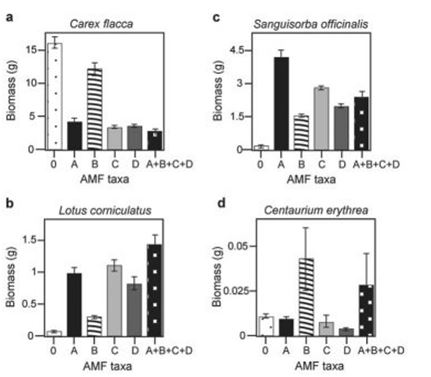Multiple Choice
Use the following information to answer the question.
There is much discussion in the media about protecting biodiversity. But does biodiversity really matter? Canadian and Swiss researchers wanted to know if the diversity of arbuscular mycorrhizal fungi (AMF) was important to the productivity of grasslands (M.G.A. van der Heijden, J. N. Klironomos, M. Ursic, P. Moutoglis, R. Streitwolf-Engel, T. Boler, A. Wiemken, and I. R. Sanders. 1998. Mycorrhizal fungal diversity determines plant biodiversity, ecosystem variability, and productivity. Nature 396:69-72) . Specifically, they wanted to know if it mattered which specific AMF species were present, or just that some type of AMF was present. They grew various plants in combination with one of four AMF species (A, B, C, and D) , no AMF species (O) , or all four AMF species together (A + B + C + D) ; and they measured plant growth under each set of conditions. All plant species were grown in each plot, so they always competed with each other, with the only difference being which AMF species were present.
On the graphs, the x-axis labels indicate the number and identity of AMF species (bar 0 = no fungi; bars A - D = individual AMF species; bar A + B + C + D = all AMF species together) . The y-axis indicates the amount (grams) of plant biomass for the species shown in italics above each graph.
Based on the van der Heijden et al. (1998) graphs in the figure, which of the following is the best description of the data supporting the idea that a plant species did not form mycorrhizae with a fungus? Its biomass is greatest when ________.
A) no AMF are present
B) AMF species A is present
C) AMF species B is present
D) AMF species C is present
Correct Answer:

Verified
Correct Answer:
Verified
Q18: Some fungal species live in plants and
Q55: When pathogenic fungi are found growing on
Q56: Early fungi probably formed mutualistic associations with
Q57: Arrange the following in order from largest
Q58: Use the information to answer the following
Q59: The adaptive advantage associated with the filamentous
Q61: Use the following information to answer the
Q62: Use the following information to answer the
Q63: Use the following information to answer the
Q64: Use the information to answer the following